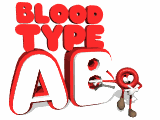Mendel's traits showed discontinuous variation because they belonged to one or more clear classes.
Many other traits show continuous variation because a number of genes affect a single trait, and
because environmental factors can influence gene expression. The greater the number of genes and
environmental factors that affect a trait, the more continuous the variation in versions of
that trait.
Dominance Relations
Incomplete Dominance: is a condition in which the dominant allele cannot completely mask
the expression of another allele. For example, red-flowered
snapdragons crossed with white ones yield
pink in the first generation. The heterozygote phenotype is somewhere between that of two
homozyotes. Crossing two heterozygotes results in a 1:2:1 ratio of white:pink:red in the
F2. The genotype can be determined by the phenotype, and the intermediate phenotype
may be the result of enzyme insufficiency. What does a cross of a heterozygote to a recessive
homozygote yield?
This animation (Audio - Important) describes
incomplete dominance.
 Codominance: is a condition in which both alleles are expressed in heterozygotes.
Codominance: is a condition in which both alleles are expressed in heterozygotes.
The gene that controls ABO blood type codes for an
enzyme that dictates the structure of a glycolipid on blood
cells. Two alleles (IA and IB) are codominant when paired. A third allele (i)
is recessive to the others.
IA and IB are each dominant to i, but are codominant to each other. Therefore,
some persons can express both genes and have AB blood.
In a blood transfusion, a recipient's immune system will attack blood cells that have an unfamiliar
glycolipid on the surface. Type O is a universal donor because it has neither type A nor type B
glycolipid.
PREVIOUS
NEXT
LECTURE 6 INDEX
MAIN INDEX
 Codominance: is a condition in which both alleles are expressed in heterozygotes.
Codominance: is a condition in which both alleles are expressed in heterozygotes. Codominance: is a condition in which both alleles are expressed in heterozygotes.
Codominance: is a condition in which both alleles are expressed in heterozygotes.